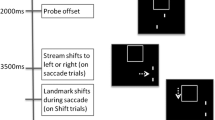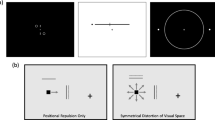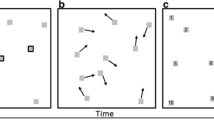Abstract
It has often been reported that, in the presence of static reference stimuli, briefly presented visual targets are perceived as being closer to the fixation point than they actually are. The first purpose of the present study was to investigate whether the same phenomenon can be demonstrated in a situation without static reference stimuli. Experiment 1, with position naming as the task, showed that such a central shift is also observed under these conditions. This finding is of importance because it completes an explanation for central near-location errors in the partial-report bar-probe task. The second purpose of the present study was to provide an explanation for these central shifts. For this explanation information about the exact size of the central shift is required. In Exps. 2, 3, and 4, with cursor setting as the task, it was attempted to assess more precisely the size of the central shifts. These experiments revealed that two different factors determine the results in cursor setting tasks; a factor “target position” and a factor “cursor position.” Experiment 5 showed that it is the point of fixation, not the fixation point, that serves, at least in part, as the reference point in this type of task. All the findings together allow us to conclude that the target positions are underestimated by about 10%. From vision research it is known that saccadic eye movements, performed for bringing a target in the fovea, also show an undershoot of about 10%. It is therefore concluded that the system in charge of saccadic eye movements also provides the metric in visual space within a single eye fixation.
Similar content being viewed by others
Author information
Authors and Affiliations
Additional information
Received: 11 February 1998 / Accepted: 25 June 1998
Rights and permissions
About this article
Cite this article
van der Heijden, A., van der Geest, J., de Leeuw, F. et al. Sources of position-perception error for small isolated targets. Psychological Research Psychologische Forschung 62, 20–35 (1999). https://doi.org/10.1007/s004260050037
Issue Date:
DOI: https://doi.org/10.1007/s004260050037




